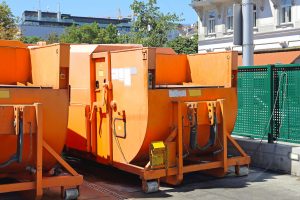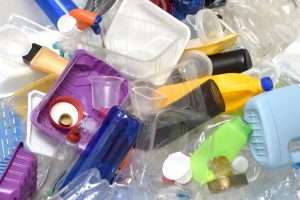by CharlieB | Oct 28, 2016

They say that necessity is the mother of invention. Every great, long-lasting improvement in technology came about because there was a need for it. We needed faster ways of transportation, so the car was invented. Drivers couldn’t see in the rain, so windshield wipers were devised. All throughout history are examples of ingenuity rising up to solve a problem. Well, one modern day problem for plant workers is how to properly get rid of waste like label matrix trim. It needs to be disposed of, and there are a many machines built just for that purpose. But trim removal systems can occasionally jam if running too quickly, and clogged machines mean wasted time and money. Plant personnel have gotten very creative when it comes to dealing with label matrix disposal. Everything from shredding to actually devising ways to use it in the machine itself. We here at KenBay have a better idea: don’t deal with it at all! Simply throw the label matrix directly into a continuous compactor at the source of the waste. Just bag it and dump it!
Why a Continuous Compactor?
You’re probably familiar with a traditional trash compactor. They’re large, they smell bad, and they are normally triggered by opening and closing the door three times. If your plant is already using one, why is a continuous compactor better?
For one thing, a continuous compactor never needs to be manually switched on. It’s right there in the name, continuous. It never shuts off on its own! A constantly rotating arm keep pressing down whatever you throw into it into neat and tidy and stackable cubes. The shape of these cubes is another great thing about continuous compactors — you’re never paying to haul around any unnecessary air when you’re getting rid of your waste. Just stack the cubes up and fill more space on the junk hauler!
Another issue is safety. We mentioned that traditional compactors are big, right? Often they’re so large that they’re immovable without additional machinery. Once you set them down, they’re not going anywhere. What does this mean for you and your employees? It means that whenever you have something like a label matrix that you need to trash, you need to leave your station and move there physically. I don’t need to tell you the risk of walking around an area with heavy active machinery! Smaller continuous compactors can be placed right at the worksite, so you can just toss the label matrix trim in when you need to and continue on with the work. In short, it helps to reduce unnecessary risk.
KenBay Helps You Manage Label Matrix Disposal
KenBay has a wide variety of inexpensive continuous compactors that are portable and easy to handle. Because they have a small footprint, it is easy to have multiple compactors at key waste disposal sites. Our line of products not only offer a safer solution to waste disposal, they are efficient as well. You won’t squander unnecessary time disposing of your waste, and you won’t pay extra money to haul air to the landfill. If you are interested in having a continuous compactor for your plant, contact us to try it before you buy it. Discover the difference the right compactor can make!
by LaurenL | Oct 21, 2016
 We know that businesses face a unique set of waste management challenges when they handle hazardous substances. Where others can send their waste to a landfill or Waste to Energy plant without a second thought, these businesses must consider additional steps. Because the responsible disposal of hazardous substances is different than the disposal of other waste products, businesses should have a separate waste management plan for hazardous materials. While daunting, it’s important to consider these processes and look for ways to improve upon them.
We know that businesses face a unique set of waste management challenges when they handle hazardous substances. Where others can send their waste to a landfill or Waste to Energy plant without a second thought, these businesses must consider additional steps. Because the responsible disposal of hazardous substances is different than the disposal of other waste products, businesses should have a separate waste management plan for hazardous materials. While daunting, it’s important to consider these processes and look for ways to improve upon them.
What are Hazardous Substances?
One challenge that manufactures sometimes face is knowing exactly what is considered a hazardous substance. To effectively manage hazardous waste, it is important to know the EPA and OSHA hazardous substance definition. It’s also important to know the state and federal requirements and laws that dictate how hazardous waste must be managed. Some of the most common types of hazardous substances often include:
- Ignitable items that easily catch on fire like solvents, paint, and gasoline
- Corrosive waste that “eats” something else, including battery acid, caustic paint strippers, and some floor cleaners
- Reactive waste that is unstable or explosive like certain cyanide and sulfide-bearing waste
- Toxic substances that are harmful when ingested or absorbed like gasoline and solvents
These are just a few hazardous substances examples. When you look for ways to improve your processes for handling hazardous waste, do thorough research. Look for a hazardous substances list that is specific to your industry, and be sure you understand the legal requirements for disposing of it.
Evaluate Your Process Repeatedly
One of the best ways you can improve your processes for handling hazardous substances is by simply monitoring your processes more often. First, you’ll need to create a plan for handling hazardous waste, using industry, state, and federal guidelines. Then, you need to evaluate that plan repeatedly. To ensure that your system is up-to-date, efficient, and safe, you need to reevaluate your procedures from time to time. At least once every quarter, set aside time to take a look at the waste products in your business. Then, find ways to improve your process.
Handle Hazardous Substances Less Often
It goes without saying that the safest way to handle hazardous substances is to not handle it all. Take a significant step to improving your processes for safely handling hazardous substances by finding ways to handle dangerous waste less often. To do this, consider a small footprint compactor that can be placed at the source of hazardous waste.
Hazardous waste compactors like our HazPac allow you to handle dangerous substances less often. In addition, the HazPac has a small footprint, high compaction rate, ease of use, and a unique ability to compact waste into bulk bags or into hazardous waste boxes. This makes our hazardous waste compactor ideal for compacting hazardous waste for transporting. In addition, because of the HazPac’s small footprint, it can be placed close to the source hazardous material generation, saving travel time and increasing safety and efficiency.
Learn More about KenBay’s Waste Management Products
We know that waste management can be a burden. But, with KenBay, you’ll have the tools you need to help make the job a little easier. The next time you evaluate your waste products and waste management strategy, consider integrating one of our industrial trash compactors into your processes.
Don’t let something like a waste get in the way of your business operations. If you’re interested in trash compactors or finding a committed consultant to help you reduce your waste, call KenBay. We can tell you more about our services, no matter what industry you’re in, or how much waste you are creating!
Photo credit: Getty Images / svengine
by LaurenL | Oct 13, 2016
 For many businesses, a common barrier to recycling is a lack of resources. For businesses that handle recyclable cans, PET bottles, or cartons, depackaging equipment can help. While there are depackaging companies that can handle this task for you, many businesses now opt to complete the simple process themselves. Typically, these types of containers are not recycled because, in order to do so, they must first be rinsed of their liquid waste. A depackaging machine can do this task for you, while also benefiting your recycling efforts in other surprising ways. Here’s how.
For many businesses, a common barrier to recycling is a lack of resources. For businesses that handle recyclable cans, PET bottles, or cartons, depackaging equipment can help. While there are depackaging companies that can handle this task for you, many businesses now opt to complete the simple process themselves. Typically, these types of containers are not recycled because, in order to do so, they must first be rinsed of their liquid waste. A depackaging machine can do this task for you, while also benefiting your recycling efforts in other surprising ways. Here’s how.
1. No Pre-Cleaning Required
Depackaging is an integral part of waste management processes for zero waste businesses in the food industry. Thanks to this technology, they can easily separate recyclable containers from the food waste that may be inside. Food depackaging equipment varies, but popular models either unscrew bottles, or perforate cans, cartons, and bottles and then rinse whatever liquid is contained inside. This is particularly good for depackaging milk, yogurt, soft drinks, BBQ sauces and ketchup, ice cream, liquid soaps and detergents, and more.
Often, precleaning keeps people from recycling. However, with the right depackaging equipment, you can simply throw full containers into the machine. These containers are perforated or unscrewed by the machine. Then, the depackaging equipment works its magic. Food waste and other liquids inside containers are removed.
2. Recyclable Material is More Easily Managed
Not only does depackaging save you time that would otherwise be devoted to emptying containers of their waste, it can also save you money in your pursuit of zero waste. The best depackaging systems also have compaction chambers. After your containers are perforated and emptied, they are shredded or compressed tightly. With depackaging equipment that also has a high compaction rate, you’ll be able to load more recyclable waste on a single truck and make fewer trips to recycling centers or Waste to Energy plants. Because of this, you’ll spend less money on managing your recyclable waste.
3. Non-recyclable Items Can Be Repurposed
A little-known fact: depackaging equipment can also help businesses manage non-recyclable items like styrofoam or other similar materials. If your business is often left with EPS Polystyrene fish boxes and packaging, EPS dust, polypropylene packaging and insulation foam, or polypropylene (EPP) packaging, depackaging equipment can help you manage this waste. Like recyclables, these items can be emptied of any waste they may hold.Then, the foam that is left over can be condensed to create large blocks of foam. These blocks can then be sold, creating a new revenue stream for your business.
Integrate Depackaging Into Your Waste Management Process with KenBay!
If you think your waste management process could benefit from depackaging, let KenBay help you find the perfect equipment to get the job done. Our SC 2000 and SC 3000 Screw Compactors are configured for depackaging, dewatering or foam densifying. If you want to make your facility landfill free, these screw compactors can be an integral part of your waste management system. Low maintenance and heavy-duty, a KenBay screw compactor is capable of handling large throughputs of material while still maintaining a high compaction rate continuously throughout the operation.
We know that waste management can be a burden. But, with KenBay, you’ll have the tools you need to help make the job a little easier. The next time you evaluate your waste products and waste management strategy, consider integrating one of our industrial trash compactors into your processes.
Because our depackaging trash compactors will reduce the weight and size of your recyclable waste, they are a great way to cut down your waste removal costs and improve the efficiency of waste management.
Don’t let something like waste get in the way of your business operations. If you’re interested in learning more about depackaging or finding a committed consultant to help you reduce your waste, call KenBay. We can tell you more about our services, no matter what industry you’re in, or how much waste you are creating!
Photo credit: Getty Images / photka
by LaurenL | Oct 7, 2016
 When was the last time you conducted a waste audit for your business? 3 years ago? 5? Maybe, never? If that’s the case, it’s time to take another look at your waste products. Every business creates waste, that’s almost a certainty, but what is done with it, where it’s sent, and how much time, money, and resources are devoted to it can vary dramatically. All businesses handle waste management in different ways. But, the businesses that manage their waste most successfully all have one thing in common. They aren’t complacent, they aren’t stagnant, they don’t continue to do the same things they’ve done for years and years.
When was the last time you conducted a waste audit for your business? 3 years ago? 5? Maybe, never? If that’s the case, it’s time to take another look at your waste products. Every business creates waste, that’s almost a certainty, but what is done with it, where it’s sent, and how much time, money, and resources are devoted to it can vary dramatically. All businesses handle waste management in different ways. But, the businesses that manage their waste most successfully all have one thing in common. They aren’t complacent, they aren’t stagnant, they don’t continue to do the same things they’ve done for years and years.
Rather, they examine their waste products and processes with regularity. They also take a strategic approach to waste management. They examine and decide in advance how waste products will be handled, before their waste lands in a landfill!
Luckily, you can do the same for your business. If you haven’t ever evaluated your waste management processes, now is the time! Here are a few things you should consider:
Reduce, Reuse, Recycle
It may seem simple, but many businesses often forget that they can ease the burden of waste management by simply reducing the amount of waste their business creates. There are plenty of ways to reduce waste products in businesses that you should consider.
Can you recycle some of your waste? Or, can you donate excess material instead of throwing it away? Can you purchase materials in bulk to reduce packaging waste? Is it more cost effective to send your waste to a Waste to Energy plant than a landfill? We all know that reducing, reusing, and recycling are great ways to help the environment. But, in businesses, these steps can also save valuable time, resources, and ultimately money.
Evaluate Your Sources of Waste Repeatedly
If you create an effective waste management strategy, your business won’t just reduce costs associated with waste management. If fact, you might even transform manufacturing waste into profits. However, to do so, you first need to create an effective waste management plan. Then, you need to evaluate it, along with you sources of waste, repeatedly. At the start of every quarter, set aside time to take a look at the waste products in your business. Then, look for new ways to improve your waste management strategies.
Manage Your Waste Products with KenBay
We know that waste management can be a burden. But, with KenBay, you’ll have the tools you need to help make the job a little easier. The next time you evaluate your waste products and waste management strategy, consider integrating one of our industrial trash compactors into your processes.
Trash compactors like KenBay’s RotoPac are ideal waste management products for industrial settings. They allow companies to reduce the volume of their trash at a ratio of six to one. The RotoPac can handle all kinds of waste from food to recyclables, and even solid hazardous waste. Because trash compactors will reduce the weight and size of your waste, they are a great way to cut down your waste removal costs and improve the efficiency of waste management.
Don’t let something like a waste get in the way of your business operations. If you’re interested in trash compactors or finding a committed consultant to help you reduce your waste, call KenBay. We can tell you more about our services, no matter what industry you’re in, or how much waste you are creating!
Photo credit: Getty Images / humbak



 We know that businesses face a unique set of waste management challenges when they handle hazardous substances. Where others can send their waste to a landfill or Waste to Energy plant without a second thought, these businesses must consider additional steps. Because the responsible disposal of hazardous substances is different than the disposal of other waste products, businesses should have a separate waste management plan for hazardous materials. While daunting, it’s important to consider these processes and look for ways to improve upon them.
We know that businesses face a unique set of waste management challenges when they handle hazardous substances. Where others can send their waste to a landfill or Waste to Energy plant without a second thought, these businesses must consider additional steps. Because the responsible disposal of hazardous substances is different than the disposal of other waste products, businesses should have a separate waste management plan for hazardous materials. While daunting, it’s important to consider these processes and look for ways to improve upon them. 
 When was the last time you conducted a waste audit for your business? 3 years ago? 5? Maybe, never? If that’s the case, it’s time to take another look at your waste products. Every business creates waste, that’s almost a certainty, but what is done with it, where it’s sent, and how much time, money, and resources are devoted to it can vary dramatically. All businesses handle waste management in different ways. But, the businesses that manage their waste most successfully all have one thing in common. They aren’t complacent, they aren’t stagnant, they don’t continue to do the same things they’ve done for years and years.
When was the last time you conducted a waste audit for your business? 3 years ago? 5? Maybe, never? If that’s the case, it’s time to take another look at your waste products. Every business creates waste, that’s almost a certainty, but what is done with it, where it’s sent, and how much time, money, and resources are devoted to it can vary dramatically. All businesses handle waste management in different ways. But, the businesses that manage their waste most successfully all have one thing in common. They aren’t complacent, they aren’t stagnant, they don’t continue to do the same things they’ve done for years and years. 